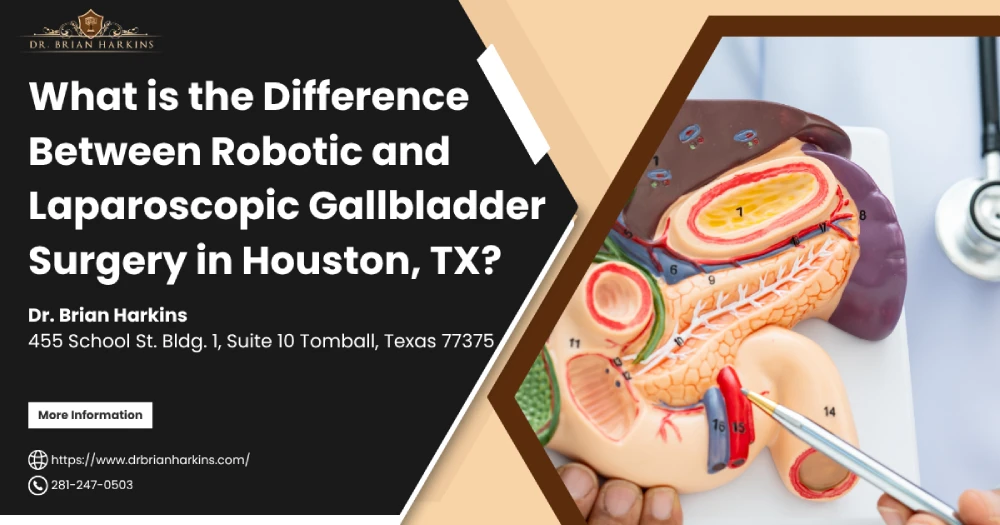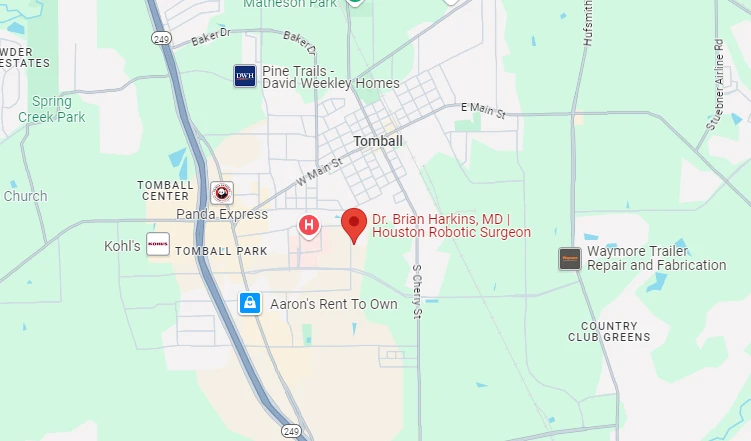
Gallbladder removal—technically called a cholecystectomy—is among the most frequently performed abdominal surgeries in the United States. Today, Houston patients can choose between two minimally invasive surgery options: standard laparoscopic surgery (the workhorse technique since the 1990s) and robotic surgery using advanced robotic technology that debuted locally in the early 2000s. Both approaches avoid the long cut of traditional open surgery, but their feel, cost, and recovery details diverge enough that it’s worth a closer look at each surgical procedure.
When gallstones clog the cystic duct or repeated attacks cause relentless pain, a gallbladder has to go. Medication and diet tweaks help only a fraction of patients; for the rest, surgery offers definitive relief without long-term digestive problems. Minimally invasive procedures dominate modern practice because they shorten recovery and leave tiny scars that disappear in Houston’s swimsuit season.
Traditional open cholecystectomy required a six-inch right-upper-quadrant incision. The laparoscopic cholecystectomy revolution of the early 1990s shrank that to four 5–10 mm ports. Two decades later, the robotic-assisted cholecystectomy emerged, promising even finer movements and 3-D vision—all while matching the small port profile of conventional laparoscopic surgery.
During a standard laparoscopic cholecystectomy, you’re asleep under general anesthesia while your surgeon and an assistant work through four trocars, watching a high-definition 2-D monitor. This standard laparoscopic surgery remains the benchmark against which every newer technology is judged.
Benefits: lower cost, quicker room setup, and virtually every general surgery team is trained in it. Limitations: rigid instruments lack wrist articulation, and 2-D vision can challenge depth perception in inflamed anatomy—particularly in cholecystectomy for acute gallbladder attacks.
A robotic-assisted cholecystectomy uses the da Vinci Xi® system found in many Houston ORs. The surgeon sits at a console, controlling EndoWrist® instruments with 540° of motion and viewing the anatomy on a 3-D, 10× magnified screen. The robot does not act autonomously; it simply translates the surgeon’s movements with tremor filtration and added dexterity.
Benefits: wrist-like articulation makes suturing and dissection around delicate ducts easier; superior ergonomics reduce surgeon fatigue; 3-D view aids precision. Limitations: longer setup, higher equipment fees, and availability limited to Houston centers that own a robotic system.
The grid below distills what Houston patients ask about most—incisions, operative time, pain, cost, and hospital stay—so you can compare robotic-assisted vs laparoscopic cholecystectomy at a glance.
| Factor | Laparoscopic Cholecystectomy | Robotic-Assisted Cholecystectomy |
|---|---|---|
| Incisions | Four 5–10 mm ports | Same number & size |
| Surgeon Position | Standing at bedside | Seated at console |
| Instrument Flexibility | Rigid, limited articulation | Wrist-like articulation, 540° |
| Typical Operative Time | 45–60 min | 60–75 min |
| Average Hospital Stay | Outpatient or overnight | Outpatient or overnight |
| Day-1 Pain Score (0–10) | 3.5 | 3.1 |
| Extra Cost to Patient* | \$0–\$500 (plan-dependent) | \$200–\$1,000 extra |
| Availability in Houston | Nearly all hospitals | Select centers with da Vinci |
*Cost varies by insurance, facility, and whether CPT add-on S2900 is covered.
Robotic arms reduce instrument collisions, easing dissection around inflamed ducts. Laparoscopy offers tactile feedback absent in current robotic surgical systems. Multiple published datasets—including 88 004 patients who underwent laparoscopic surgery vs 25 084 who underwent robotic-assisted surgery—show comparable complication rates, affirming the comparative safety of robotic-assisted vs laparoscopic approaches.
You’re not only picking technology; you’re choosing a team, a hospital, and a schedule that matches your life. Understanding the impact of robotic tools, insurance nuances, and surgeon proficiency helps you decide which minimally invasive path is best.
Robotic surgery over standard laparoscopic surgery adds capital costs, but whether that translates to higher patient bills depends on your insurance design. Studies of Medicare beneficiaries who underwent cholecystectomy with continuous Medicare coverage show robotic-assisted cholecystectomy was associated with higher facility charges yet similar 90-day readmission expenses.
The use of open cholecystectomy decreased dramatically in Houston as these minimally invasive options expanded, but remember: high-deductible plans shift more cost to you. Always request a No Surprises Act good-faith estimate.
Good preparation smooths recovery, whether you select robotic-assisted or standard laparoscopic surgery. Follow these evidence-based tips used by patients who underwent laparoscopic or robotic cholecystectomy at our practice.
Both robotic-assisted and conventional laparoscopic surgery deliver the benefits of minimally invasive gallbladder removal: tiny scars, reduced pain, and fast recovery from Houston’s heat. Robots add wrist-like precision and 3-D vision; laparoscopy offers proven reliability at a lower entry cost. The deciding factors are surgeon skill, case complexity, and your personal priorities on scheduling and expense—not the gadget itself. Talk openly with your surgical team, review the comparative safety of robotic-assisted vs laparoscopic techniques, and choose the path that feels right for your body and budget.
Most major insurers, Medicare, and many HMOs classify robotic-assisted cholecystectomy under the general laparoscopic cholecystectomy umbrella, but some plans list a separate technology code (S2900) that adds a modest copay. Call the member services line on your card and ask specifically about “robotic-assisted vs. laparoscopic cholecystectomy coverage” to avoid surprises.
Large multicenter analyses—including one with 088 000 cases—show comparable overall complication rates. Robotic arms may lower bile duct injury risk when near-infrared imaging is used, but the absolute difference is tiny. Surgeon experience remains the strongest predictor of safety outcomes in either minimally invasive procedure.
Both robotic and laparoscopic patients typically go home the same day or after one overnight observation. Exceptions include severe inflammation, significant comorbidities, or unexpected findings that convert the case to traditional open surgery. Discuss individual discharge criteria with your care team in advance.
The number and size of skin incisions are virtually identical: four small ports measuring 5–10 mm each. Some surgeons can offer a single-incision robotic approach through the navel, but it’s not yet routine in Houston and may carry higher hernia risk compared with standard laparoscopic port placement.
Yes, but timing and inflammation level matter. Severe swelling can limit safe port placement, leading some surgeons to prefer conventional laparoscopic conversion. Others favor robotic arms for greater dexterity in dense tissue. Ask whether your surgeon performs robotic procedures during acute cholecystitis cases.
Houston cohort studies report similar return-to-work timelines—about five days for desk jobs—whether patients underwent laparoscopic surgery or robotic surgery. Some robotic patients use fewer narcotics early on, which can translate to quicker mobility, but length-of-recovery differences are minimal overall.
Anesthesia charges are virtually equal for both techniques. Supply costs differ: robotic-assisted surgery uses proprietary instrument tips that raise per-case expenses by \$600–\$1,000. Hospitals pass part of that fee to insurers, which may influence your deductible share under certain plans.
Tactile feedback helps surgeons “feel” tissue tension during dissection. Standard laparoscopic sticks provide some sensation, while current robotic systems rely on visual cues alone. Expert robotic surgeons compensate with high-definition 3-D vision and experience, achieving comparable safety outcomes of robotic-assisted cholecystectomy.
Early data suggest a slightly lower conversion rate for robotic-assisted versus laparoscopic surgery, likely due to improved dexterity and visualization. However, conversions remain uncommon overall (<1 %) in experienced hands, and no randomized trial has demonstrated a decisive advantage.
Yes, but attending surgeons remain in full control at the console. The da Vinci system allows dual consoles so trainees can participate under real-time supervision. If you prefer the attending alone to perform your cholecystectomy, simply discuss this preference during the informed-consent meeting.


Dr. Brian Harkins is a renowned surgeon specializing in advanced, minimally invasive, and robotic surgical techniques. With a dedication to innovation and personalized patient care, he has transformed countless lives by delivering exceptional outcomes.

I want a website like this, where do i start?